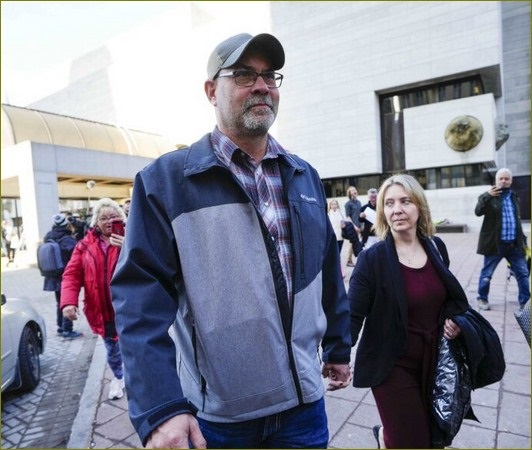Freedom Convoy
Pierre Poilievre doesn’t like anti-Trudeau flags, but understands anger behind them

By Lee Berthiaume in Ottawa
Federal Conservative Leader Pierre Poilievre says he doesn’t like the expletive-laden flags some Canadians are using to denounce Prime Minister Justin Trudeau, but that he understands the anger fuelling such displays.
“I don’t like the flags, and I don’t like rage,” Poilievre said during an end-of-year news conference in Ottawa on Friday. “But I think we have to ask ourselves: ‘Why are people so angry?’ And the answer is that they’re hurting.”
The comments follow a blog post by former Conservative leader Erin O’Toole, who said one of his hopes for 2023 “is to see fewer profanity-laden Trudeau flags across Canada.”
Describing Trudeau as his political opponent in the last federal election, not his enemy, O’Toole wrote: “These flags and the hyper-aggressive rhetoric that often accompanies them are slowly normalizing rage and damaging our democracy.”
O’Toole’s criticism was not limited to only those who have flown the flags targeting Trudeau, as he accused actors on both the extreme right and left of contributing to a growing polarization in Canadian politics by playing off each other.
“The proliferation of these types of political displays in recent years are a sign that we are slowly becoming desensitized to political stunts and aggressive rhetoric whether it comes from the left or right,” he added.
The anti-Trudeau flags have become particularly linked to the “Freedom Convoy” protests, whose members Poilievre courted during his successful run for the Conservative leadership earlier this year. The Conservative caucus had ousted O’Toole as leader just days into the weeks-long protest in Ottawa.
Asked about O’Toole’s blog post and the flags, Poilievre said it’s easy for politicians to tell people to stop complaining. However, he added that many Canadians are angry because they are hurting financially and in other ways.
“I have never seen so much hurt and so much pain and suffering in our population during my nearly two decades in politics,” he said.
“So sure, let’s tell people to be more civil. But as political leaders, let’s actually try to solve the problems that have upset and angered and hurt people so badly. It is our job to turn that hurt into hope.”
Poilievre went on to suggest many Canadians are struggling because the Liberal government is out of touch, before promising to be a prime minister “that actually bring people together and gives them hope that tomorrow can be better.
“Let’s make this a place where people feel their hard work pays off, where they’re respected, where their leaders don’t talk down to them and point fingers at them.”
This report by The Canadian Press was first published Dec. 30, 2022.
COVID-19
Chris Barber asks Court to stay proceedings against him

Chris Barber leaves the courthouse in Ottawa after the verdict was delivered in his trial with fellow Freedom Convoy organizer Tamara Lich, on Thursday, April 3, 2025. (Photo credit: THE CANADIAN PRESS/Justin Tang)
“Chris Barber consistently followed the legal advice that he received from police officers, lawyers, and a Superior Court judge.”
The Justice Centre for Constitutional Freedoms announces that Chris Barber has asked the Ontario Court of Justice for a stay of proceedings against him. He argues that the legal advice given to him by police officers, lawyers, and a Superior Court judge during the Freedom Convoy was erroneous and that, as a result, the Crown is not entitled to convict him.
On April 3, 2025, Justice Heather Perkins-McVey of the Ontario Court of Justice found Mr. Barber guilty of mischief and of counselling others to breach a court order. That decision followed upon a lengthy 45-day trial stretching from September 2023 to September 2024.
Diane Magas, Chris Barber’s lawyer, filed a Stay of Proceedings Application with the Court on April 16, 2025. In that Application, Mr. Barber and his legal team argue that he did, in fact, seek legal advice regarding his actions during the Freedom Convoy protest.
For example, he followed Ottawa Police Services directions on where to park trucks in downtown Ottawa. When an officer asked him to move his truck, “Big Red,” from downtown Ottawa, he moved it. On February 7 and 16, 2022, his lawyer at the time advised him that Justice Maclean of the Superior Court had confirmed that the protest could continue so long as it continued to be peaceful and safe.
In essence, Chris Barber and his legal team are now arguing that he followed all legal advice that was given to him in 2022, but that some of the legal advice he was given turned out to be erroneous.
His Application argues for a stay of proceedings against him on the grounds that “he sought advice from lawyers, police officers, and a Superior Court Judge on the legality of the protest he was involved in.”
This Application was filed one day after Chris Barber was informed that the Crown was pursuing a two-year prison sentence against him. In an April 15 Facebook post, Mr. Barber wrote, “My family got bad news today. The Crown prosecutor wants to lock Tamara Lich and me in prison for two years-for standing up for freedom. They also want to [seize] my truck, Big Red, and crush her like she’s just scrap metal or sell it at auction.”
If the Application is successful, Mr. Barber would not see prison time, nor would his truck be seized.
“Throughout the peaceful Freedom Convoy, Chris Barber did what any law-abiding Canadian would do: seeking out and acting upon the best legal advice available to him,” stated John Carpay, President of the Justice Centre. “Chris Barber consistently followed the legal advice that he received from police officers, lawyers, and a Superior Court judge.”
“To hold a well-meaning man behind bars for two years and to confiscate his property, as is now demanded by the Crown, would bring the administration of justice into disrepute,” Mr. Carpay continued. “Crown prosecutors are painting a portrait of a dangerous criminal, even while Chris Barber sought out and followed legal advice when participating in the Freedom Convoy in Ottawa in 2022. Chris worked within the law when peacefully exercising his Charter freedoms of expression, assembly and association.”
COVID-19
Tamara Lich and Chris Barber trial update: The Longest Mischief Trial of All Time continues..

Here are the last two posts on Tamara Lich’s Substack posted April 16 and April 17:
April 17:
We weren’t able to secure a date yesterday for the sentencing hearing and instead another ‘speak to’ was set for April 28. In addition to time needed to enter numerous impact statements (coincidentally and conveniently comprised of individuals suing us for $300,000,000.00), the Crown has added a forfeiture order to seize Big Red which will add significant time to argue. Therefore I suspect all parties will need to find 4-5 days in their schedules for the sentencing hearing.
The Crown is also seeking two years in federal prison for each of us.
Three days were tentatively set aside at the end of May for a Stay of Proceedings application put forth yesterday by Ms. Magus on Chris’ behalf.
And so The Longest Mischief Trial of All Time continues to plod along, still no end in sight.
April 16:
In our trial, the longest mischief trial of all time, we set hearing dates to set hearing dates.
There will be a ‘speak to’ this afternoon to set a date for the sentencing hearing which we think will take 3-4 days. Following that hearing, Chris and I will return to Ottawa again for the actual sentence.
The Crown is seeking 2 years in a federal penitentiary for both of us, plus they have decided to file an application to confiscate Big Red. Funny, there hasn’t been a single other convoy case in which the Crown demanded that persons property or vehicle, yet they seem to want Big Red. You need to ask yourself why.
Chris raised his children in that truck, changed their diapers in that truck, had his old dog, Buddy, put to sleep in the passenger seat when his time came because that was Buddy’s favourite place in the world.
This is not about the rule of law.
It’s about crushing a Canadian symbol of Hope, Pride & Unity
-

 2025 Federal Election2 days ago
2025 Federal Election2 days agoStudy links B.C.’s drug policies to more overdoses, but researchers urge caution
-

 2025 Federal Election2 days ago
2025 Federal Election2 days agoPolls say Canadians will give Trump what he wants, a Carney victory.
-

 2025 Federal Election2 days ago
2025 Federal Election2 days agoPoilievre’s Conservatives promise to repeal policy allowing male criminals in female jails
-

 2025 Federal Election2 days ago
2025 Federal Election2 days agoCarney Liberals pledge to follow ‘gender-based goals analysis’ in all government policy
-

 2025 Federal Election2 days ago
2025 Federal Election2 days agoTrump Has Driven Canadians Crazy. This Is How Crazy.
-

 Entertainment1 day ago
Entertainment1 day agoPedro Pascal launches attack on J.K. Rowling over biological sex views
-

 2025 Federal Election2 days ago
2025 Federal Election2 days agoThe Anhui Convergence: Chinese United Front Network Surfaces in Australian and Canadian Elections
-

 conflict1 day ago
conflict1 day agoTrump tells Zelensky: Accept peace or risk ‘losing the whole country’




